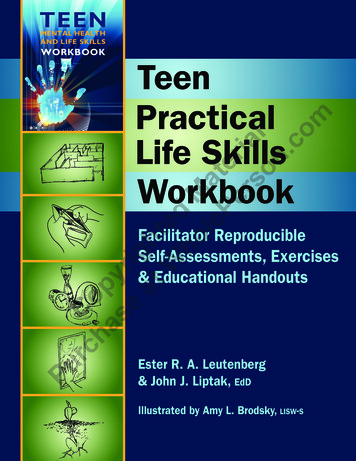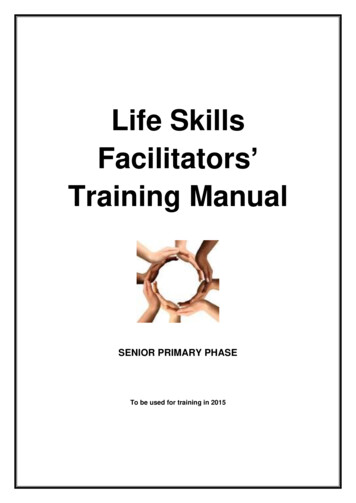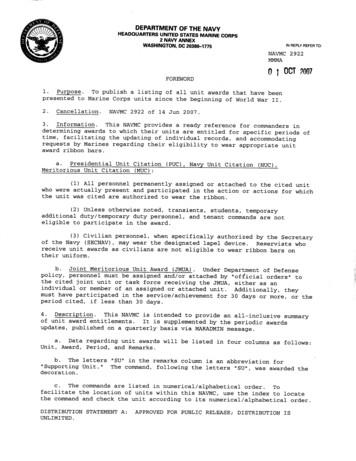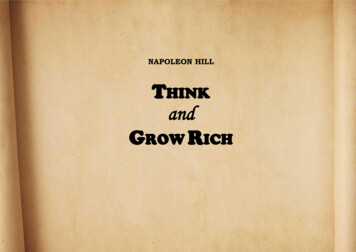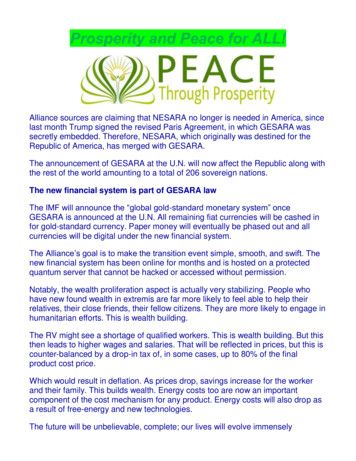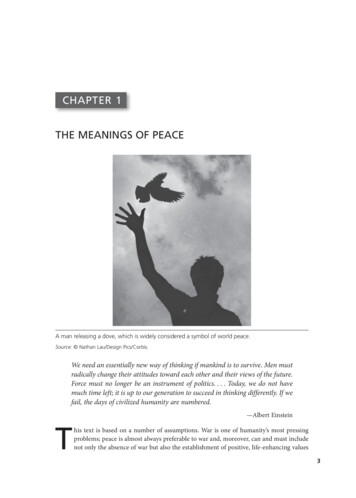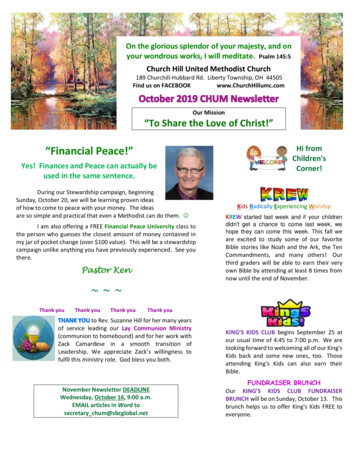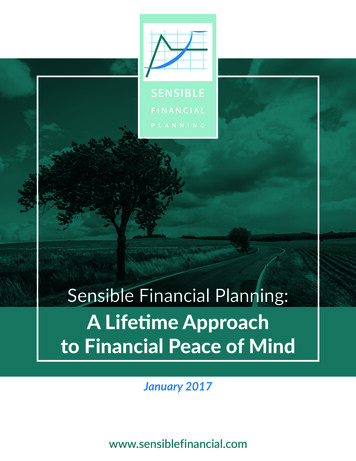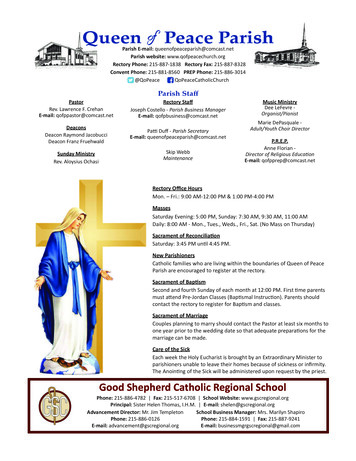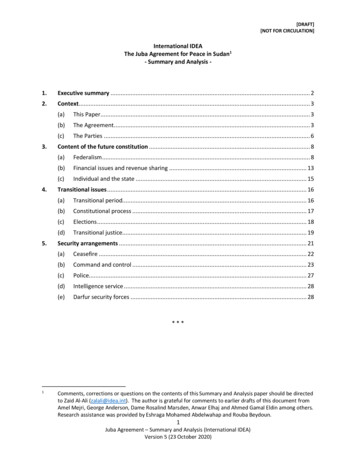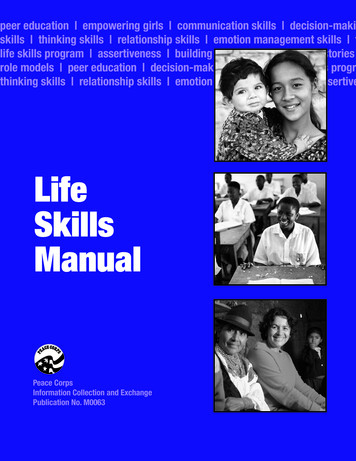
Transcription
peer education empowering girls communication skills decision-makinskills thinking skills relationship skills emotion management skills tlife skills program assertiveness building a bridge exchanging storiesrole models peer education decision-making skills the life skills progrthinking skills relationship skills emotion management skills assertiveLifeSkillsManualPeace CorpsInformation Collection and ExchangePublication No. M0063
Information Collection and ExchangeThe Peace Corps Information Collection and Exchange (ICE), a unit of the Office of OverseasProgramming and Training Support (OPATS), makes available the strategies and technologiesdeveloped by Peace Corps Volunteers, their co-workers, and their counterparts to developmentorganizations and workers who might find them useful. ICE works with Peace Corps technicaland training specialists to identify and develop information of all kinds to support Volunteersand overseas staff. ICE also collects and disseminates training guides, curricula, lesson plans,project reports, manuals, and other Peace Corps-generated materials developed in the field.Some materials are reprinted “as is”; others provide a source of field-based information for theproduction of manuals or for research in particular program areas. Materials that you submit toICE become part of the Peace Corps’ larger contribution to development.This publication was produced by Peace Corps OPATS. It is distributed through the ICE unit.For further information about ICE materials (periodicals, books, videos, etc.) and informationservices, or for additional copies of this manual, please contact ICE and refer to the ICE catalognumber that appears on the publication.Peace CorpsOffice of Overseas Programming and Training SupportInformation Collection and Exchange1111 20th Street, NW, Sixth FloorWashington, DC 20526Tel: 202.692.2640Fax: 202.692.2641Abridged Dewey Decimal Classification (DDC) Number: 303.44Share your experience!Add your experience to the ICE Resource Center. Send your materials to us so we can share themwith other development workers. Your technical insights serve as the basis for the generation ofICE materials, reprints, and training materials. They also ensure that ICE is providing the mostup-to-date innovative problem-solving techniques and information available to you and yourfellow development workers.
Life Skills ManualPeace Corps2001Information Collection and ExchangePublication No. M0063Reprinted
Life Skills Manual Peace Corps
ContentsContentsAcknowledgments.5Part I: The Life Skills Program–Background and Introduction.7Welcome to the Life Skills Program!. 9Lessons Learned. 15Sample Schedules. 22Session 1: The Bridge Model: How Do We Build a Bridge From Information to Behavior Change? . 27Session 2: Identifying the Missing Life Skill. 36Part II: Peer Education.39Peer Educators. 41Session 1: Dealing With Problems in Groups. 45Session 2: Support for Responsible Behavior . 49Part III: Facing Facts about HIV/AIDS and STDs.53Facing Facts about HIV/AIDS and STDs. 55Session 1: Facts and Myths about HIV/AIDS. 57Session 2: The Immune System. 62Session 3: How HIV is Transmitted. 68Session 4: The Relationship of STDs and HIV/AIDS. 73Session 5: Women and HIV/AIDS. 77Session 6: HIV Prevention. 83Session 7: Disease Progression and Positive Behaviors. 88Session 8: Cure or Treatment?. 93Session 9: HIV/AIDS and Human Rights. 98Session 10: HIV/AIDS and Behavior Change. 104Part IV: Communication Skills.109Session 1: Communication Puzzle.111Session 2: Assertiveness: Attack and Avoid. 117Session 3: Assertiveness: Passive, Assertive, Aggressive. 121Session 4: Assertiveness: Assertive Messages. 127Session 5: Assertiveness/Peer Pressure: Responding to Persuasion—Part I. 132Session 6: Assertiveness/Peer Pressure: Responding to Persuasion—Part II. 137P art V: Decision–Making Skills.143Session 1: Steps in Making a Good Decision. 145Session 2: Just Between Us. 149Session 3: Exchanging Stories—Role Models (“The Person I Admire”). 152Session 4: Your Life Story. 156Session 5: Your Goals. 159Session 6: Early Pregnancy. 163
Life Skills ManualSession 7: Alcohol and Drug Use. 165Session 8: Risk Behavior—Testing the Waters. 169Session 9: Delaying Sex. 174Part VI: Relationship Skills.181Session 1: The Best Response Game. 183Session 2: Oh! Henry! and Managing Emotions Gallery Walk. 187Session 3: Peer Pressure Role Plays. 190Session 4: What is Love?. 193Session 5: Self–Esteem Building: Do We Have Self–Esteem?. 196Session 6: Self–Esteem Building: “A Pat on the Back”. 199Session 7: What are Gender Roles?—Gender Cards Exercise. 201Session 8: Gender Picture Codes and Role Plays. 205Session 9: Gender and Culture: Ideal Images and Personal Destroyers. 211Session 10: Whose Rights and Who’s Right: A Look at Bride Price. 214Part VII: Bringing It All Together.217Forum Theater. 219Appendices.225Appendix I: Warm–Ups and Energizers. 227Appendix II: Quick Breaks!. 238Appendix III: Assorted Ideas. 239Appendix IV: Games and Session Ideas. 244 Peace Corps
AcknowledgmentsAcknowledgmentsThis Life Skills Manual was compiled and adapted from materials created by the following organizations: World Health Organization; United Nations Educational, Scientific and Cultural Organization (UNESCO); Alice Welbourn and ACTIONAID; theCurriculum Development Unit, Ministry of Education, Zimbabwe; and UNICEF, Harare.We gratefully acknowledge the talent and skill of the authors of those materials.The Peace Corps also appreciates the work of Kathleen Callahan, who developed theLife Skills Manual, and Ruth Mota, African Health Specialist, the author of the “FacingFacts about HIV/AIDS and STDs” section. Additional thanks are due the developmentteam: Judee Blohm and Lani Havens for editing, and Therese Wingate for illustrationsand graphic design. Finally, we appreciate the ideas and photographs shared by Volunteers, Counterparts, and staff throughout the world, especially Peace Corps/Malawi andTovwirane Centre, and the efforts of all those who participated in this process.
Life Skills Manual Peace Corps
andIntroductionPart I:Program–The Life SkillsBackground and Introduction Part IP art I: Background
Life Skills Manual Peace Corps
LifeandIntroductionWelcome to theSkills Program!Are you a health worker struggling with the rising rates of Human Immuno–Deficiency Virus/Acquired Immune Deficiency Syndrome (HIV/AIDS), SexuallyTransmitted Diseases (STDs), unwanted pregnancy, or maternal mortality? Are youa teacher working daily with young people who face difficult decisions: determininga positive direction in life, potential unwanted pregnancy, or the issues of alcoholor drug use? Have you been providing health information for years and yet seeno positive change in your community? Are you a parent, community volunteer,or concerned community leader fearful of the toll HIV/AIDS is taking on yourarea? Are you a young person ready to do something to help lead your friends intoa brighter future? If you answered “yes” to any of the above questions, the LifeSkills program might be for you.The Life Skills ConceptThe Life Skills program is a comprehensive behavior change approach thatconcentrates on the development of the skills needed for life such as communication, decision–making, thinking, managing emotions, assertiveness,self–esteem building, resisting peer pressure, and relationship skills. Additionally, it addresses the important related issues of empowering girls and guidingboys towards new values. The program moves beyond providing information.It addresses the development of the whole individual—so that a person willhave the skills to make use of all types of information, whether it be related toHIV/AIDS, STDs, reproductive health, safe motherhood, other health issues, andother communication and decision–making situations. The Life Skills approachis completely interactive, using role plays, games, puzzles, group discussions,and a variety of other innovative teaching techniques to keep the participantwholly involved in the sessions. Part IP art I: Background
Life Skills ManualInformation is Not EnoughAlthough it is important to provide information in the early phases of a behaviorchange intervention and to reinforce such knowledge periodically, informationis rarely enough to motivate people to change behavior. If that seems hard toimagine, just think about a behavior that you’ve been trying to change over theyears. Maybe it is reading more, exercising, eating a better balance of foods,or quitting smoking. Have you successfully made the change? Have you ever“relapsed” back into the behavior? What are some of the factors that have keptyou from changing?Principles of Behavior Change andHow the Life Skills Program Mirrorsthese PrinciplesChanging behavior is always difficult, but changing sexual behavior is especially tricky. Various organizations have developed behavior change models,including the U.S. National Academy of Sciences (NAS). The seven principleslisted below are based in part on the NAS work.Principles of Behavior ChangeHow the Life Skills ProgramMirrors these Principles1. Providing information is the logi1. The Life Skills program assumescal starting point in any behaviorthat you will begin by teachingchange effort. Information, althoughbasic information about HIV/AIDS,necessary, is rarely enough by itselfSTDs, unwanted pregnancy, drugs,to produce behavior change in mostor other pressing communitypeople. The information must beproblems. [Extensive informationeasily understood and relevant toabout HIV/AIDS is provided in thisthe individuals you are trying tomanual in “Part III: Facing Factsreach.about HIV/AIDS and STDs.”]2. Fear messages have limited use in2. When working with Life Skills,motivating behavioral change. Ifavoid fear and negativity, andfear is overwhelming it can hinder,instead focus on positive mesrather than help efforts to change.sages—creating, maintaining, andToo much fear may cause people toreinforcing healthy behaviors, anddeny they are at risk, to rationalizeworking towards a better life forby pointing to others who have praceveryone in the community—youngticed similar behaviors and survived,people, women, men, and Peopleand to avoid seeking medical care alLiving with HIV/AIDS (PLWHAs).together. Using words like “scourge”or “plague” or showing picturesof emaciated “AIDS victims” maycause people not only to ostracizethose infected, but to deny their ownrisks for contracting the infection.10Peace Corps
3. People are more likely to try behaviors they feel capable of performing.It is important to teach people theskills for engaging in the desired behaviors. Seeing examples of peopleengaging in the healthy behavior willhelp a person believe that he or shetoo can engage in that behavior.3. Life Skills systematically attemptsto build skills for healthy behavior.This is the crux of the Bridge Modelof behavior change (see page 33).Many programs provide “one–shot”information to large numbers ofpeople. A Life Skills program workswith a small group of people overa longer period of time to motivateparticipants to adopt a new behavior, to teach and model the skillsnecessary to successfully adoptthat behavior, and to continuallyreinforce those new skills, untilparticipants “feel capable of performing” healthier behavior. Peereducators can further reinforce this,as they provide a positive exampleof healthy behavior.4. Individuals are more likely to adopta new behavior if they are offeredchoices among alternatives. Forexample, rather than just promotingabstinence or condoms, give rangesof possible behaviors that reducerisk, like practicing less risky sexualbehaviors, getting an HIV test withyour partner, and so on.4. Life Skills helps develop criticalthinking skills so participants learna number of alternatives in dealingwith a difficult situation. Participants are thus exposed to manychoices in terms of negotiatinghealthier behavior.5. Campaigns should create environments that encourage change. Workto change social norms in favor ofhealthy behavior. Peer educationprograms provide a support basefor change, as accepted peers modelbehaviors. Working with communityleaders or a PLWHA group aroundan HIV/AIDS program can reducethe stigma of the disease and create an environment that encourageschange.5. Because change is easier if one’senvironment encourages it, LifeSkills programs emphasize workingwith a community holistically. Forexample, if you are interested inworking with young people, firstprovide a Training–of–Trainers(TOT) to community leaders suchas mayors or chiefs, headmasters,government officials and parents.Then have a TOT for teachers inthe school in which you work, or ifyou are working with young peopleoutside the school system, considertraining the nearest adult rolemodels in that community. Thoseworkshops introduce the entirecommunity to the program, createthe possibility that those trained willbegin programs of their own withtheir new skills, and will serve as apowerful support to the program thatyou begin with young people. Youmay also wish to consider trainingyouth peer educators before movingandIntroduction11Part IP art I: Background
Life Skills Manualto the target of your program, theyouth in a particular school or area.If a PLWHA group operates in yourcommunity, be sure to include it inevery aspect of your project.6. Change is more likely in a community if influential people adopt thechange.6. Since it is clear that influentialpeople can drive change, peereducators can be an effectiveaddition to your Life Skills program.Young people often seek health orsex–related information from theirpeers before discussing these issueswith adults. Training influentialyoung people to serve as rolemodels in their peer group can thusdramatically increase the impactof your program. Some advice onworking with peer educators can befound in “Part II: Peer Education.”7. Relapse is expected. Therefore,any program that seeks to changebehaviors over time needs to buildin ways to maintain those behaviorsand to help bring people “back onthe path” to positive behaviors afterthey have relapsed.7. Because relapse is expected, it isimportant to continually recreate theBridge Model to assist those whohave already fallen into damagingbehaviors. You may need to designa slightly different approach to the“planks” in the bridge for youngwomen who have gotten pregnantand expelled from school, for drug–addicted youth, or for PLWHAs, forexample.Pages 10–12 adapted with permission from “Principles of Behavior Change,” an article byThomas Coates, Ph.D., Center for AIDS Prevention Studies at the University of California, SanFrancisco.12Peace Corps
andIntroductionThe Bridge Model of Behavior ChangeInformation provides a solid foundation.Begin by providing accurate health information.Our goal is to see members of our communities livinghealthy, happy, fulfilling lives.But in order to realize a positive, healthy life, we need to avoid theconsequences of negative behavior.A Life Skills Program focuses on building the “planks” in the bridge—working on theindividual skills that help people to make healthier decisions about their lives.Relapse is expected in any behavior change, so we must build in “life-preservers” or waysto bring people back onto the “bridge” should they suffer the consequences of a negative behavior.13Part IP art I: Background
Life Skills ManualAbout the ManualAlthough originally developed in Africa, this manual has been re–edited for globaldistribution. Be sure to adapt each and every session to make it more appropriate to your local culture. This may mean translating into local language, changingnames or situations in role plays, changing the entire content of a session, and possibly even discarding some sessions altogether. Re-create the content of the manualto make it applicable to your area.The manual consists of over 50 different lesson ideas that you can use with anygroup: anti–AIDS clubs, girls’ clubs, boys’ clubs, youth clubs, women’s groups, andso forth. The manual is written with a strong bias towards youth work and healthissues. These lessons are quite easy to adapt to any age and other topics, however.Consider them as a starting point, so that you will have initial lesson plans ready asyou begin to work with participants. Working with your colleagues, you can developother lesson ideas and activities that will continue to challenge your participants tocritically think about and modify their behaviors. In addition to the lesson plans,some lessons learned regarding peer education are included, as are some sampleschedules, and tips to facilitators.The sessions are grouped according to three basic life skills: communication,decision–making, and relationship skills. These are loose categories and there isa great deal of overlap among them. “Part IV: Communication Skills” focuses onassertiveness, responding to persuasion, active listening, and body language. “PartV: Decision–Making Skills” includes assessing risk, exploring choices, understanding consequences, planning for the future, critical thinking, and goal setting. “PartVI: Relationship Skills” provides session ideas for the topics of gender, culture,peer pressure, self–esteem, and managing emotions. While you may present thesessions in any order that you choose, there is a logical flow to each section—allowing new skills to build on previous ones. “Part VII: Bringing It All Together”provides a powerful tool for practicing and evaluating all of the life skills, so thatyou may assess participants’ assimilation of the topics covered. The “Appendices”provide numerous warm–ups, games, and other suggestions for keeping the sessionsinteractive, lively, and fun.“Part III: Facing Facts about HIV/AIDS and STDs” is crucial to facilitating all othersections. If you are about to begin the program, it is suggested that you learn thissection well, so that you will be able to answer the many questions that will ariseregarding HIV and STDs. If you have any questions or need clarification regardingthis or any other health issue addressed in the book, it is recommended that youcontact the appropriate health department or ministry in your country for up–to–dateinformation or refer to any of the Websites listed in “Part III: Facing Facts aboutHIV/AIDS and STDs.” If you are a Peace Corps Volunteer, you may also contactyour Associate Peace Corps Director (APCD), health trainer, or the Peace CorpsMedical Officer (PCMO) for more information.14Peace Corps
andIntroductionLessons LearnedLessons Learned—Tips forImplementing Life SkillsBelow are some suggestions for effectively implementing a Life Skills program: Remember that this manual is only a template. Adapt the individual sessionsand/or the entire approach to your local situation and language. Before starting, perform an assessment of the community to help tailor theprogram to specific local needs. The “Assessments and Evaluations” ideasin the next section may be useful in helping you structure your communityassessment. Always work with community leaders first. Our community leader workshopsand meetings have proven invaluable in keeping the program supported. If yourwork is going to be with students, meet with the headmasters and teachers firstso that they will understand the program, possibly help in the implementation,and reinforce the content in class. Some wonderful things can happen if thecommunity gets energized to do Life Skills. They may even start programswithin their own groups—in churches, women’s organizations, and so forth. Consider all of the positives and negatives before deciding whether to incorporate peer educators into the program. A peer educator approach may not be rightfor every situation. Make sure you will be able to support your peer educatorsbefore embarking on such a program. It is possible to do Life Skills withoutpeer educators. For a discussion on the pros and cons of peer educators, see“Part II: Peer Education.” If you do decide to work with peer educators, be sure to send letters home toparents about the program. Let them know exactly what you are doing. Beupbeat and congratulate them that their son or daughter was chosen for suchan important program. Remember to write in the local language. Do not limit your Life Skills approach to youth or to HIV/AIDS only. Life Skillscan be implemented in many different populations! Adapt, adapt, adapt!15Part IP art I: Background
Life Skills Manual If you are surprised that the emphasis on HIV prevention espoused in this manualis not on exploring alternatives to sex and other issues around sexuality, do notbe concerned! We found that when we set out to talk about sex, we got littlecooperation from participants. But when we were talking about other issuessuch as communication, relationships, and so forth, sexuality always came up.An “indirect” approach may be more culturally appropriate. Once your program or your peer educators are working well at the secondaryschool or teenage level, consider getting permission to send them into your localprimary school to conduct sessions with the upper grades of elementary school. You may not need money or resources to implement this program on the locallevel. If you are working within a school, you might make Life Skills activities part of an after school club. If you are working at the community level,Life Skills sessions may be part of your daily or weekly group activities—inchurches, women’s groups, AIDS committees, or wherever! If you are working at the district level or other area where funding is necessaryfor trainings, some organizations that might be supportive include UNICEF,Peace Corps Small Projects Assistance (SPA), and local clubs such as Rotary orLion’s Clubs. Be sure to explore the NGOs and other funding options in yourarea first as they will be the most sustainable means of support.Lessons Learned—Assessmentsand EvaluationsAlthough Peace Corps Volunteers (PCVs) and Counterparts typically conductParticipatory Rural Appraisal (PRA), Participatory Analysis for Community Action (PACA), or other needs assessments when they are first posted to their sites,many resist the idea of conducting assessments before beginning a program likeLife Skills. With only two years to implement projects, Volunteers often feel thattime does not permit additional assessment activities. Similarly, health workers andteachers in the field are already overburdened with work; they may be unwillingto begin each new program with an assessment of the community. Although theseconcerns are valid, it is crucial for the success of any behavior change program thatthe facilitators have an understanding about the attitudes in communities in whichthey serve. Assessments are thus an important first step.How do Assessments Help? An assessment of the community before implementing the Life Skills programcan help you to— Raise awareness of key issues before beginning the program.— Network with community leaders and members.16Peace Corps
andIntroduction— Determine the current level of understanding of the issues addressed by lifeskills in the community. This will provide a baseline to help you to measurebehavior change that might occur as a result of the program.— Discover the most appropriate subgroups in the community in which totarget the program, for example women’s groups, out–of–school youth,girls’ clubs, church groups, and so forth.— Tailor the Life Skills program to meet the needs of the community. Short reassessments at various points in the program can— Indicate the strong aspects of the program, as well as those that might beimproved.— Help you determine new priorities and approaches.— Bolster your confidence and renew your energy as you see the programbegin to work! If the program is about to end or transition, an evaluation can— Help determine to what degree the project has achieved knowledge, attitude,skills, and behavior change in the community.— Point to any changes that could be implemented to improve the program.— Indicate whether or not the program is an effective tool for behaviorchange.— Provide guidance in terms of how the program might be replicated in otherareas.— Be used to secure donor funding to continue or expand the project.— Re
The Life Skills Concept The Life Skills program is a comprehensive behavior change approach that concentrates on the development of the skills needed for life such as com-munication, decision–making, thinking, managing emotions, assertiveness, self–esteem building, resisting peer pres

